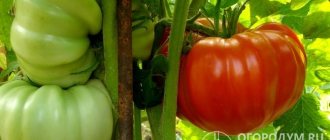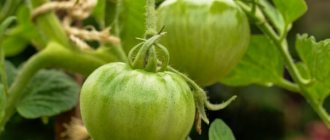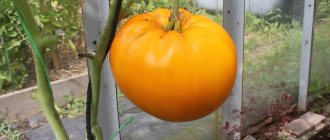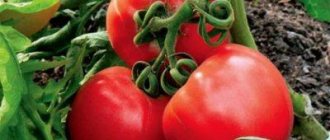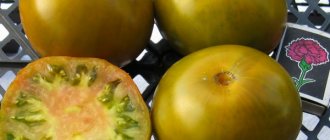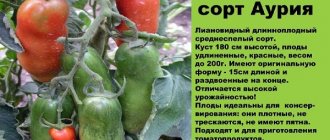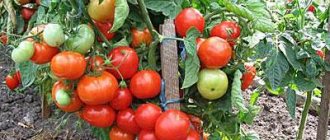» Vegetable growing » Tomatoes » Growing lemon giant tomato
0
901
Article rating
Among all the tomato varieties, one of the brightest and most delicious is the Lemon Giant tomato. It was bred by breeders at NK.LTD, a research and production corporation located in the city of Shchelkovo in Russia. Testing of the new variety was carried out for several years and only in 2000 it was added to the State Register.
- Features of cultivation
- Growing seedlings
- Rules for sowing seeds
- Care
- Transplanting seedlings into open ground
- Care
- Reviews from gardeners
Growing Giant Lemon Tomato
Description and main characteristics of yellow tomato
The “Lemon Giant” variety fascinates lovers of exotic tomatoes with its fruits. They are bright lemon color, beautifully shaped, large and very tasty. Therefore, after trying tomatoes for the first time, I want to grow them on my own plot. In addition, tall plants greatly enhance the area with their decorative properties.
To ensure that the result does not disappoint, before planting you need to familiarize yourself with the characteristics and agricultural technology requirements of the original large-fruited tomatoes:
- The tall variety refers to the average ripening period.
- Growing method. “Lemon Giant” tomatoes are planted both in open ground and in greenhouses. In open ground, large-fruited tomatoes are slightly smaller, but the number of fruits is greater than in greenhouse cultivation.
- The type of bush is indeterminate. The plant grows few leaves. In the greenhouse, bushes of tall, large-fruited tomatoes reach a height of 2.5 meters, so gardeners need to form stems and tie up powerful plants. For proper formation, regular pinching of bushes will be required. In open ground they will be lower, but without tying and pinching, the Lemon Giant variety may not meet the vegetable grower’s expectations.
- Fruit. Large, multi-chambered, ribbed, the weight of one tomato with good care reaches 700-900 grams. The color of the tomatoes is rich lemon yellow. The pulp is not watery, but juicy and sweet, with hints of lemon flavor. The skin of tomatoes is strong, but not dense, thanks to it the fruits do not crack. Green tomatoes “Lemon Giant” ripen at room temperature without losing their taste.
- The nutritional value is high. The fruits contain sufficient amounts of vitamin C and beta-carotene to nourish the human body. The variety is useful in the diet, for vitamin deficiency and colds.
The general parameters of tall, large-fruited tomatoes help to assess the capabilities of the site and the summer resident for growing the crop. But besides these indicators, it is important to know all the pros and cons of the original variety.
Video
We invite you to watch a video on the topic of the article:
About the author:
Graduated from MGRI named after. Ordzhonikidze. My main specialty is a mining geophysicist, which means a person with an analytical mind and varied interests. I have my own house in the village (accordingly, I have experience in vegetable gardening, horticulture, mushroom growing, as well as fiddling with domestic animals and poultry). Freelancer, a perfectionist and a “borer” regarding his duties. Handmade lover, creator of exclusive jewelry made from stones and beads. A passionate admirer of the written word and a reverent observer of everything that lives and breathes.
Found a mistake? Select the text with the mouse and click:
Ctrl + Enter
Do you know that:
Convenient Android applications have been developed to help gardeners and gardeners. First of all, these are sowing (lunar, flower, etc.) calendars, thematic magazines, and collections of useful tips. With their help, you can choose a day favorable for planting each type of plant, determine the timing of their ripening and harvest on time.
Advantages and disadvantages of tomato
In addition to the description, photos and recommendations of the manufacturer, the main source of information about the variety is considered to be reviews from vegetable growers. Those who grew this variety on their plot highlight the following advantages:
- large fruit, very pleasant taste and aroma of tomatoes;
- high stable yield with proper care;
- nutritional value of tomatoes;
- good keeping quality and transportability of large-fruited tomatoes;
- Plants rarely get sick if given enough attention.
Gardeners also note some disadvantages of large-fruited tomatoes, although it would be easier to attribute them to varietal characteristics:
- Demanding requirements of a tall tomato to the watering regime. Nightshades are sensitive to the quality and quantity of moisture. Therefore, to get a good harvest, you have to water the large-fruited tomato variety correctly.
- Dietary requirements. The large-fruited Lemon Giant tomato will not show its qualities without proper nutrition. Gardeners should familiarize themselves with the variety’s fertilizing schedule in advance.
- Demanding on soil fertility. On poor land, a tall tomato will not be able to demonstrate varietal large-fruit and productivity. The tomatoes will be smaller in size and the number of fruits on the bush will be significantly lower.
If we look at the shortcomings from a different angle, we can say that these are the usual requirements of elite tomatoes. To get extraordinary fruits, you have to work hard.
Reviews about the variety from those who planted
The tomato variety “Giant Lemon” is in great demand and popular among gardeners, who speak extremely positively about it. Experienced vegetable growers consider the “Giant Lemon” tomato to be a rather interesting variety, the cultivation of which requires some experience. That is why novice gardeners are recommended to start with growing more unpretentious tomato varieties, and after acquiring experienced skills, begin cultivating the “Giant Lemon” variety.
Crochet blouse for girls: pattern for a knitted warm cape, learning how to make an openwork blouse using photos and videos
Review from a gardener:
The tomato variety “Giant Lemon” will be a real find for gardeners who love healthy and tasty fruits. Despite the small number of shortcomings, which vegetable growers include timely fertilizing, adherence to temperature conditions and proper watering, if all recommendations are strictly followed, you can get a good harvest of bright yellow-lemon fruits.
Agricultural technology for growing seedlings
Tomatoes of mid-season large-fruited varieties are recommended to be grown in seedlings, especially in regions with a cool climate.
Do not use fresh seeds for sowing. Take 2-3 years old to increase germination percentage.
The sowing date is determined by several criteria:
- climatic features of the region;
- weather conditions of the current year;
- date of expected planting in the ground;
- recommendations of the lunar sowing calendar.
Usually this is the period of the first half of March.
Important! Before sowing, be sure to soak the seeds of large-fruited tomatoes in a growth stimulator solution for 12 hours.
The second important action with planting material is disinfection. Seeds of tall tomatoes are kept in a solution of potassium permanganate or hydrogen peroxide for 10-15 minutes. Then they dry and begin sowing.
Prepare fertile soil and containers in advance. The soil and containers must also be disinfected before sowing the seeds of tall tomatoes. If it is not possible to prepare the soil mixture yourself, then it is safer to buy ready-made soil in a specialized store. It should be light so that tomato seedlings do not suffer from stagnant moisture. After all, the yield of the large-fruited variety “Lemon Giant” directly depends on the quality of grown tomato seedlings.
The containers are filled with soil mixture, the top layer is leveled and grooves are made 2 cm deep. Seeds of tall, large-fruited tomatoes are placed in them and sprinkled with soil. It is advisable to moisten the soil in advance so as not to water after sowing the seeds. You just need to lightly spray the grooves with water from a spray bottle, protecting the seeds of large-fruited tall tomatoes from being washed out.
Now you need to cover the containers with film to maintain humidity and the desired temperature. The ideal temperature for the germination of tall, large-fruited Lemon Giant tomatoes is considered to be 24°C - 25°C.
As soon as the first sprouts appear on the soil surface, the container is transferred to a place with good lighting.
Caring for tomato seedlings consists of watering, nutrition, picking and prevention.
Seedlings of large-fruited tomatoes can be planted twice. In this way, they stimulate the formation of a powerful root system in tall varieties of tomatoes. The first time the procedure is carried out in the unfolding phase of the first pair of true leaves. Tomato seedlings are replanted after 2 weeks.
Important! Be careful not to damage the root system of plants at the time of picking.
Planting tall tomatoes in a greenhouse is scheduled for the second decade of May. Pre-install trellises for gartering tall, large-fruited “Lemon Giant” tomatoes. Plants are planted in a permanent location according to the recommended scheme. No more than 3 bushes of large-fruited tomatoes are placed on 1 square meter of area.
Landing
Plants are planted in a permanent location when the ground warms up to +10°C. The age of the seedlings by this time should reach 45–60 days. The timing of seed sowing is determined depending on the climatic conditions of the region.
For tomatoes, loose, nutritious soil, rich in humus, with good moisture permeability is recommended. Use universal soil or a special soil mixture for tomatoes.
Seeds are sown in separate cups or a common planting container. Seeds are purchased in stores or collected independently from the largest fruits of uniform color. After 5–7 days, shoots appear.
Growing seedlings
The variety is sensitive to changes in temperature and humidity. A favorable microclimate is created for seedlings. Recommended temperature +18…25°C. Cold temperatures at night are especially dangerous.
The bushes quickly gain mass with regular feeding. Mineral complexes are added with watering every two weeks. The recommended dose is halved for foliar treatment.
When the plants are too long, it is necessary to add additional light to the young bushes, increasing the daylight hours to 12 hours a day. Incandescent lamps generate too much heat, so LED lamps are installed.
Landing in the ground
Tomatoes are planted in holes that exceed the volume of the pot by 3 cm on all sides. It is advisable to throw a handful of wood ash at the bottom. Then carefully remove the seedlings from the pot, without damaging the earthen ball, and place them in the hole. When the plants are long, the hole is deepened or the stem is laid in a semicircle along the earthen wall.
After good watering, the roots of the plant are covered with soil mixture, and the top of the planting is mulched with dry humus or high-moor peat. During the first week, it is advisable to shade the seedlings from the scorching sun.
Caring for adult tomatoes
Regardless of where large-fruited tall “Lemon Giant” tomatoes are grown, they require shaping, gartering and pinching.
Plants are formed into 1-2 stems. For open ground, the formation of 2 stems is suitable; in greenhouses, it is better to form one. This helps avoid crowding of tall plants. The lower leaves and side shoots are removed.
It is necessary to tie up plants. The large-fruited, tall variety "Lemon Giant" is famous for its yield, so the stems need help in holding the clusters.
Fertilizing for tall, large-fruited varieties is necessary. It is necessary to apply complex mineral fertilizers three times during the growing season. Nitrogen components can be introduced with organic compounds, potassium - with the help of wood ash. Additionally, the bushes are sprayed on the leaves with a complex of microelements.
Pinching is another agrotechnical nuance for those who want to get very large fruits. It allows you to regulate the yield of large-fruited tall tomatoes of the Lemon Giant variety. After the third cluster, the shoot is pinched, and no more than 2 fruits are left in the cluster. In this case, the tomatoes grow to gigantic sizes.
Watering is plentiful, but not frequent. Take warm water and water it in the evening.
Video
We invite you to watch a video on the topic of the article:
Graduated from MGRI named after. Ordzhonikidze. My main specialty is a mining geophysicist, which means a person with an analytical mind and varied interests. I have my own house in the village (accordingly, I have experience in vegetable gardening, horticulture, mushroom growing, as well as fiddling with domestic animals and poultry). Freelancer, a perfectionist and a “borer” regarding his duties. Handmade lover, creator of exclusive jewelry made from stones and beads. A passionate admirer of the written word and a reverent observer of everything that lives and breathes.
Found a mistake? Select the text with the mouse and click:
You need to collect medicinal flowers and inflorescences at the very beginning of the flowering period, when the content of nutrients in them is highest. Flowers are supposed to be picked by hand, tearing off the rough stalks. Dry the collected flowers and herbs, scattered in a thin layer, in a cool room at natural temperature without access to direct sunlight.
In little Denmark, any piece of land is a very expensive pleasure. Therefore, local gardeners have adapted to growing fresh vegetables in buckets, large bags, and foam boxes filled with a special earthen mixture. Such agrotechnical methods make it possible to obtain a harvest even at home.
In Australia, scientists have begun experiments in cloning several varieties of grapes grown in cold regions. Climate warming, which is predicted for the next 50 years, will lead to their disappearance. Australian varieties have excellent characteristics for winemaking and are not susceptible to diseases common in Europe and America.
One of the most convenient methods for preparing a harvest of vegetables, fruits and berries is freezing. Some believe that freezing causes the nutritional and health benefits of plant foods to be lost. As a result of the research, scientists have found that there is practically no decrease in nutritional value when frozen.
“Frost-resistant” varieties of garden strawberries (more often simply “strawberries”) need shelter just as much as ordinary varieties (especially in those regions where there are snowless winters or frosts alternating with thaws). All strawberries have superficial roots. This means that without shelter they freeze to death. Sellers’ assurances that strawberries are “frost-resistant,” “winter-hardy,” “tolerates frosts down to −35 ℃,” etc. are deception. Gardeners must remember that no one has yet managed to change the root system of strawberries.
Natural toxins are found in many plants; Those grown in gardens and vegetable gardens are no exception. Thus, the seeds of apples, apricots, and peaches contain hydrocyanic acid, and the tops and peels of unripe nightshades (potatoes, eggplants, tomatoes) contain solanine. But do not be afraid: their number is too small.
Convenient Android applications have been developed to help gardeners and gardeners. First of all, these are sowing (lunar, flower, etc.) calendars, thematic magazines, and collections of useful tips. With their help, you can choose a day favorable for planting each type of plant, determine the timing of their ripening and harvest on time.
Humus is rotted manure or bird droppings. It is prepared like this: the manure is piled up in a heap or pile, layered with sawdust, peat and garden soil. The pile is covered with film to stabilize temperature and humidity (this is necessary to increase the activity of microorganisms). The fertilizer “ripens” within 2-5 years, depending on external conditions and the composition of the feedstock. The output is a loose, homogeneous mass with a pleasant smell of fresh earth.
A new product from American developers is the Tertill robot, which weeds weeds in the garden. The device was invented under the leadership of John Downes (creator of the robot vacuum cleaner) and works autonomously in all weather conditions, moving over uneven surfaces on wheels. At the same time, it cuts off all plants below 3 cm with the built-in trimmer.
https://fermoved.ru/pomidoryi/gigant-limonnyj.htmlhttps://otomatah.ru/tomat-gigant-limonnyj.htmlhttps://ogorodum.ru/tomat-gigant-limonnyj-opisanie-sorta-foto-i- otzyvy.html
Pests and diseases
The large-fruited variety “Lemon Giant” is famous for its resistance to viral and fungal infections, verticillium, and fusarium. Preventative tillage of the soil before planting will help protect plants from diseases even more reliably. In the greenhouse, the soil is disinfected with a solution of potassium permanganate, Fitosporin, and copper sulfate. This procedure will also help reduce the number of pest larvae that harm large-fruited Lemon Giant tomatoes - cutworms, whiteflies. In case of insect infestation, insecticides or folk compositions are used.
It is important to maintain humidity and temperature conditions indoors to prevent problems from occurring.
